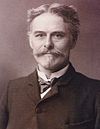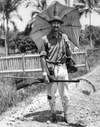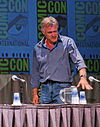Selected articles covering Reptiles and human science, culture, and economics
Hensley was part of a large family that had moved between Tennessee and Virginia, before settling in Tennessee shortly after his birth. Following his conversion, he traveled through the Southeastern United States, teaching a form of Pentecostalism that emphasized strict personal holiness and frequent contact with venomous snakes. Although illiterate, he became a licensed minister of the Church of God (Cleveland, Tennessee) in 1915. After traveling through Tennessee for several years conducting Church of God-sanctioned services, he resigned from the denomination in 1922. Hensley was married four times and fathered thirteen children.
In 1955, while conducting a service in Florida, he was bitten by a snake and became violently ill. He refused to seek medical attention and died the following day. Despite his personal failings, he convinced many residents of rural Appalachia that snake handling was commanded by God, and his followers continued the practice after his death. Although snake handling developed independently in several Pentecostal ministries, Hensley is generally credited with spreading the custom in the Southeastern United States. (see more...)The Bone Wars is the name given to a period of intense fossil speculation and discovery during the Gilded Age of American history, marked by a heated rivalry between Edward Drinker Cope and Othniel Charles Marsh. The two paleontologists used underhanded methods to out-compete the other in the field, resorting to bribery, theft, and destruction of bones. The scientists also attacked each other in scientific publications, attempting to ruin the other's credibility and cut off his funding.
Originally colleagues who were civil to each other, Cope and Marsh became bitter enemies after several personal slights between them. Their pursuit of bones led them west to rich bone beds in Colorado, Nebraska, and Wyoming. From 1877 to 1892, both paleontologists used their wealth and influence to finance their own expeditions and to procure services and fossils from dinosaur hunters. By the end of the Bone Wars, both men exhausted their funds in fueling their intense rivalry.
Cope and Marsh were financially and socially ruined by their efforts to disgrace each other, but their contributions to science and the field of paleontology were massive; the scientists left behind tons of unopened boxes of fossils on their deaths. The feud between the two men led to over 142 new species of dinosaurs being discovered and described. The products of the Bone Wars resulted in an increase in knowledge of ancient life, and sparked the public's interest in dinosaurs, leading to continued fossil excavation in North America in the decades to come. Several historical books and fictional adaptations have also been published about this period of intense paleontological activity. (see more...)Bone Sharps, Cowboys, and Thunder Lizards is a graphic novel written by Jim Ottaviani and illustrated by the company Big Time Attic. The book tells a slightly fictionalized account of the Bone Wars, a period of intense excavation, speculation, and rivalry which led to a greater understanding of dinosaurs in the western United States. This novel is the first semi-fictional work written by Ottaviani; previously, he had taken no creative license with the characters he depicted, portraying them strictly according to historical sources.
Bone Sharps follows the two scientists Edward Drinker Cope and Othniel Marsh as they engage in an intense rivalry for prestige. Ottaviani has Cope and Marsh interact and meet many important figures of the Gilded Age, from P. T. Barnum to U.S. Grant, as the two scientists pursue their hotheaded and sometimes illegal acquisitions of fossils. Unlike in his previous books, "the scientists are the bad guys this time". Upon release, the novel received praise from critics for its exceptional historical content, although some reviewers wished more fiction had been woven into the story. (see more...)Edward Drinker Cope (July 28, 1840 – April 12, 1897) was an American paleontologist and comparative anatomist, as well as a noted herpetologist and ichthyologist. Cope distinguished himself as a child prodigy, publishing his first scientific paper at the age of nineteen. Cope later married and moved from Philadelphia to Haddonfield, New Jersey, although Cope would maintain a residence and museum in Philadelphia in his later years.
Cope had little formal scientific training, and he eschewed a teaching position for field work. He made regular trips to the American West prospecting in the 1870s and 1880s, often as a member of United States Geological Survey teams. A personal feud between Cope and paleontologist Othniel Charles Marsh led to a period of intense fossil-finding competition now known as the Bone Wars. Cope's financial fortunes soured after failed mining ventures in the 1880s. He experienced a resurgence in his career toward the end of his life before dying in 1897.
Cope's scientific pursuits nearly bankrupted him, but his contributions helped to define the field of American paleontology. He was a prodigious writer, with 1,400 papers published over his lifetime, although his rivals would debate the accuracy of his rapidly published works. He discovered, described, and named more than 1,000 vertebrate species including hundreds of fishes and dozens of dinosaurs. His proposals on the origin of mammalian molars and for the gradual enlargement of mammalian species over geologic time ("Cope's Law") are notable among his theoretical contributions. (see more...)William Beebe was an American naturalist, ornithologist, marine biologist, entomologist, explorer, and author. He is remembered for the numerous expeditions he conducted for the New York Zoological Society, his deep dives in the Bathysphere, and his prolific scientific writing for both academic and popular audiences.
Born in Brooklyn, New York Beebe left college before obtaining a degree in order to work at the then newly opened New York Zoological Park, where he was given the duty of caring for the zoo's birds. Beebe participated in a series of research expeditions, including one intended to document the world's pheasants. He published an account of his pheasant expedition titled A Monograph of the Pheasants.
During the course of his expeditions Beebe gradually developed an interest in marine biology, ultimately leading to his 1930s dives in the Bathysphere off the coast of Bermuda. These dives represented the first time a biologist observed deep-sea animals in their native environment. Later, Beebe returned to the tropics and founded a tropical research station which remains in operation as part of the Asa Wright Nature Centre. Beebe's research there continued until his death in 1962.
He is also remembered for several theories he proposed about avian evolution which are now regarded as having been ahead of their time, particularly his 1915 hypothesis that the evolution of bird flight passed through a four-winged or "Tetrapteryx" stage, which has been supported by the 2003 discovery of Microraptor gui. (see more...)The Crystal Palace Dinosaurs, also known as Dinosaur Court, are a series of sculptures of extinct animals (including dinosaurs) and mammals in Crystal Palace Park, now in the London borough of Bromley. Commissioned in 1852 to accompany the Crystal Palace after its move from the Great Exhibition in Hyde Park and unveiled in 1854, they were the first dinosaur sculptures in the world, pre-dating the publication of Charles Darwin's On the Origin of Species by six years. While to varying degrees inaccurate by modern standards, the models were designed and sculpted by Benjamin Waterhouse Hawkins under the scientific direction of Sir Richard Owen, representing the latest scientific knowledge at the time. The models were classed as Grade II listed buildings from 1973, extensively restored in 2002, and upgraded to Grade I listed in 2007. The models represent fifteen genera of extinct animals, not all dinosaurs. They are from a wide range of geological ages, and include true dinosaurs, ichthyosaurs, and plesiosaurs mainly from the Mesozoic era, and some mammals from the more recent Cenozoic era. (see more...)
Cultural depictions of dinosaurs have been numerous since the word dinosaur was coined in 1842. The dinosaurs featured in books, films, television programs, artwork, and other media have been used for both education and entertainment. The depictions range from the realistic, as in the television documentaries of the 1990s and first decade of the 21st century, or the fantastic, as in the monster movies of the 1950s and 1960s.
The growth in interest in dinosaurs since the Dinosaur Renaissance has been accompanied by depictions made by artists working with ideas at the leading edge of dinosaur science, presenting lively dinosaurs and feathered dinosaurs as these concepts were first being considered. Cultural depictions of dinosaurs have been an important means of translating scientific discoveries to the public.
Cultural depictions have also created or reinforced misconceptions about dinosaurs and other prehistoric animals, such as inaccurately and anachronistically portraying a sort of "prehistoric world" where many kinds of extinct animals (from the Permian animal Dimetrodon to mammoths and cavemen) lived together, and dinosaurs living lives of constant combat.
Other misconceptions reinforced by cultural depictions came from a scientific consensus that has now been overturned, such as the alternate usage of dinosaur to describe something that is maladapted or obsolete, or dinosaurs as slow and unintelligent. (see more...)There have been a number of potential species assigned to the carnosaurian dinosaur genus Allosaurus since its description in 1877 by Othniel Charles Marsh, but only a handful are still regarded as valid. Allosaurus was originally described from material from the Upper Jurassic Morrison Formation of the western United States of America; the type species A. fragilis became one of the best-known species of dinosaur. The genus Allosaurus was part of the Marsh/Cope "Bone Wars" of the late 19th century, and its taxonomy became increasingly confused due to the competition, with several genera and species named by Cope and Marsh now regarded as synonyms of Allosaurus or A. fragilis. Since the description of Allosaurus, scientists have proposed additional species from such far-flung locales as Portugal, Siberia, Switzerland, and Tanzania, and unnamed remains from Australia and China have also been assigned to the genus at one time or another. (see more...)
Mary Anning (1799 – 1847) was a British fossil collector, dealer, and palaeontologist who became known around the world for important finds she made in Jurassic marine fossil beds in the cliffs along the English Channel at Lyme Regis in the county of Dorset in Southwest England. Her work contributed to fundamental changes in scientific thinking about prehistoric life and the history of the Earth.
Mary Anning searched for fossils in the area's Blue Lias cliffs. Her discoveries included the first ichthyosaur skeleton correctly identified; the first two plesiosaur skeletons found; the first pterosaur skeleton located outside Germany; and important fish fossils. Her observations played a key role in the discovery that coprolites, known as bezoar stones at the time, were fossilised faeces. She also discovered that belemnite fossils contained fossilised ink sacs like those of modern cephalopods.
Anning did not fully participate in the scientific community of 19th-century Britain, who were mostly Anglican gentlemen. She struggled financially for much of her life. Her family was poor, and her father, a cabinetmaker, died when she was eleven. She became well known in geological circles in Britain, Europe, and America. Nonetheless, as a woman, she was not eligible to join the Geological Society of London and she did not always receive full credit for her scientific contributions. After her death in 1847, her unusual life story attracted increasing interest. (see more...)Jurassic Park is a 1993 American science fiction adventure film directed by Steven Spielberg. It is the first installment of the Jurassic Park franchise. It is based on the 1990 novel of the same name by Michael Crichton, with a screenplay written by Crichton and David Koepp. The film centers on the fictional Isla Nublar, an islet located off Central America's Pacific Coast, near Costa Rica Nicaragua border, where a billionaire philanthropist and a small team of genetic scientists have created a wildlife park of cloned dinosaurs.
Following an extensive $65 million marketing campaign, which included licensing deals with 100 companies, Jurassic Park grossed over $900 million worldwide in its original theatrical run. It surpassed Spielberg's 1982 film E.T. the Extra-Terrestrial to become the highest-grossing film until Titanic (1997). Jurassic Park was well received by critics, who praised its special effects and Spielberg's direction but criticized the script. The film won more than 20 awards (including 3 Academy Awards), mostly for its visual effects. Jurassic Park is considered by many to be one of the greatest films of the 1990s and in some cases of all time, as well as a landmark in the vector of visual effects regarding its computer-generated imagery and animatronics.
Jurassic Park was followed by two sequels, The Lost World: Jurassic Park and Jurassic Park III, both of which were box office successes but received mixed critical responses. A third sequel, Jurassic World, is set for release on June 12, 2015. (see more...)Jurassic Park III is a 2001 American science fiction adventure monster film. It is the third installment in the Jurassic Park franchise and a sequel to the 1997 film The Lost World: Jurassic Park. It is the series' first film that was not directed by Steven Spielberg nor based on a book by Michael Crichton (though numerous scenes in the film were ultimately taken from Crichton's novels Jurassic Park and The Lost World). The film takes place on Isla Sorna, off Central America's Pacific coast, the island featured in the second film, where a divorced couple has tricked Dr. Alan Grant into going in order to help them find their son. After the success of Spielberg's Jurassic Park, Joe Johnston expressed interest in directing a sequel, a film adaptation of The Lost World. Spielberg instead gave Johnston permission to direct the third film in the series, if there were to be one. Production of Jurassic Park III began on August 30, 2000. Upon its release, the film received mixed reviews, with many praising the visual effects and action scenes but finding the plot clichéd and unoriginal. Despite being less well-received than the previous films, Jurassic Park III was a box office success, grossing $368 million worldwide. (see more...)
Portal:Reptiles/Science, culture, and economics articles/13
Portal:Reptiles/Science, culture, and economics articles/14
Portal:Reptiles/Science, culture, and economics articles/15
Portal:Reptiles/Science, culture, and economics articles/16
Portal:Reptiles/Science, culture, and economics articles/17
Portal:Reptiles/Science, culture, and economics articles/18
Portal:Reptiles/Science, culture, and economics articles/19
Portal:Reptiles/Science, culture, and economics articles/20
Portal:Reptiles/Science, culture, and economics articles/21









